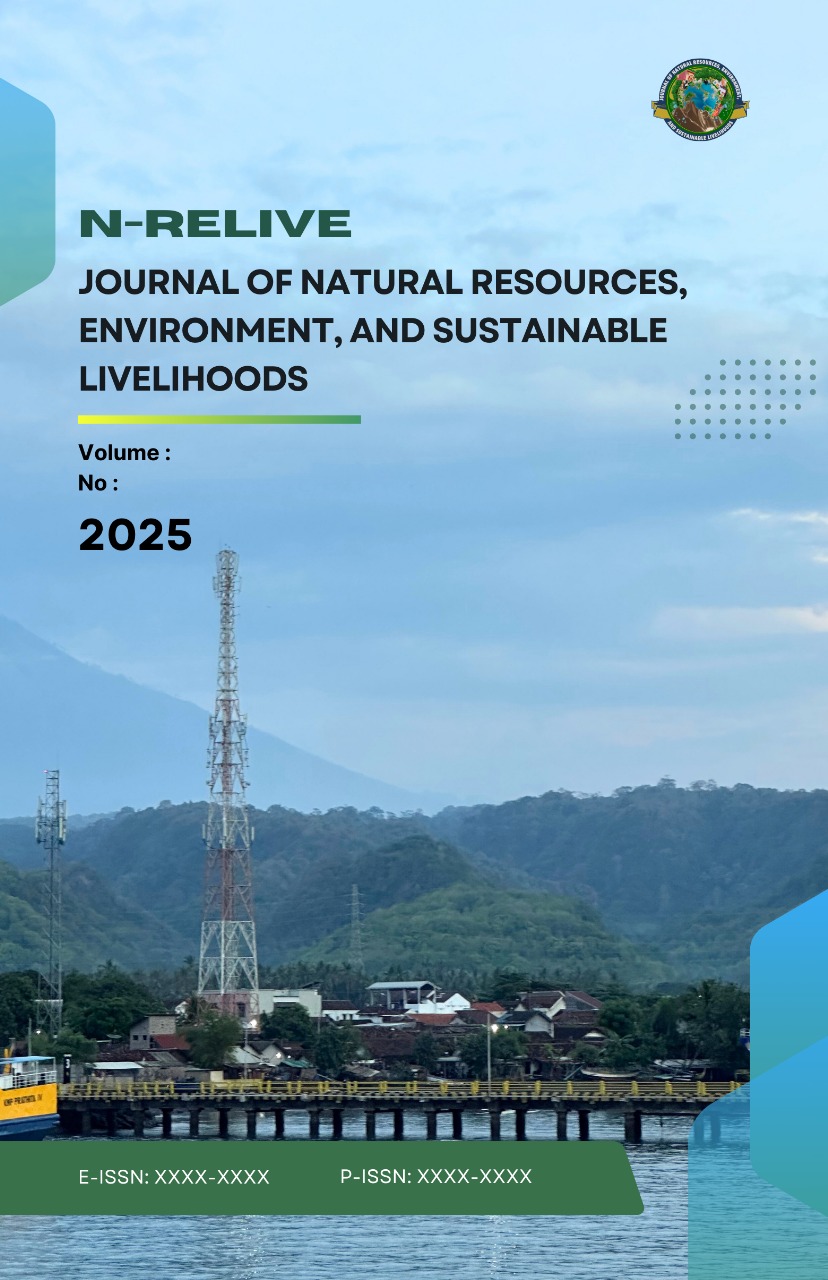The Effectiveness of Trichoderma viride in suppressing stem rot (Sclerotium rolfsii) and enhancing growth and yield of porang
Keywords:
Porang, Sclerotium Rolfsii, Stem rot, Trichoderma virideAbstract
Porang is a commodity that commands a high price due to the numerous benefits of its tubers. Root rot caused by Sclerotium Rolfsii is one of the main diseases affecting porang. One control measure that can be implemented is the use of the biological agent Trichoderma Viride. The aim of this study is to determine the most effective dose of T. viride in a solid formulation for controlling stem rot caused by S. rolfsii. This research was conducted at the Forecasting for Plant Pest Organisms facility in Jatisari, Karawang, from September 2021 to April 2022. The research design employed was a Completely Randomized Block Design (CRBD) with a single factor. The doses used were 0 (as control), 50, 75, 100, 125, and 150 grams per plant. T. viride was propagated using rice as the medium. The study involved six doses of T. viride in a solid formulation with four replications. Data analysis was performed using ANOVA at a 5% significance level, followed by DMRT at the same level. T. viride at a dose of 150 grams per plant resulted in the best suppression of root neck rot intensity at 69.17% and suppression of tuber rot percentage at 69.46%. The application of T. viride was able to increase the growth and yield of porang.
Downloads
References
Aktar, W., Sengupta, D., & Chowdhury, A. (2009). Impact of pesticides use in agriculture: their benefits and hazards. Interdisciplinary Toxicology, 2(1), 1-12. https://doi.org/10.2478/v10102-009-0001-7.
Amaria, W., Harni, R., & Wardiana, E. (2018). Pengaruh dosis dan frekuensi aplikasi biofungsida Trichoderma terhadap infeksi Rigidoporus microporus pada benih karet. Jurnal Tanaman Industri dan Penyegar, 5(2), 49-58. http://124.81.126.59/handle/123456789/8264.
Barus, S., Tarigan, R., & Hutabarat, R. C. (2018). Pengaruh Pemberian Tiga Isolat Trichoderma spp terhadap Pertumbuhan Vegetatif dan Produksi Kentang Var Granola. Jurnal Agroteknosains, 1(2), 124-129. https://www.portaluniversitasquality.ac.id:5388/ojssystem/index.php/AGROTEKNOSAINS/article/download/37/48.
Agens pengendali hayati (APH) – Bagian 3 : Trichoderma spp. SNI 8027.3:2014, (2014). https://pdfcoffee.com/sni-trichoderma-5-pdf-free.html
Contreras-Cornejo, H. A., Macías-Rodríguez, L., Alfaro-Cuevas, R., & López-Bucio, J. (2014). Trichoderma spp. Improve Growth of Arabidopsis Seedlings Under Salt Stress Through Enhanced Root Development, Osmolite Production, and Na+ Elimination Through Root Exudates. Molecular Plant-Microbe Interactions®, 27(6), 503-514. https://doi.org/10.1094/mpmi-09-13-0265-r.
Contreras-Cornejo, H. A., Macías-Rodríguez, L., Vergara, A. G., & López-Bucio, J. (2015). Trichoderma Modulates Stomatal Aperture and Leaf Transpiration Through an Abscisic Acid-Dependent Mechanism in Arabidopsis. Journal of Plant Growth Regulation, 34(2), 425-432. https://doi.org/10.1007/s00344-014-9471-8.
Garnica-Vergara, A., Barrera-Ortiz, S., Muñoz-Parra, E., Raya-González, J., Méndez-Bravo, A., Macías-Rodríguez, L., . . . López-Bucio, J. (2016). The volatile 6-pentyl-2H-pyran-2-one from Trichoderma atroviride regulates Arabidopsis thaliana root morphogenesis via auxin signaling and ETHYLENE INSENSITIVE 2 functioning. New Phytologist, 209(4), 1496-1512. https://doi.org/10.1111/nph.13725.
Goldman, G. H., Hayes, C., & Harman, G. E. (1994). Molecular and cellular biology of biocontrol by Trichoderma spp. Trends in Biotechnology, 12(12), 478-482. https://doi.org/10.1016/0167-7799(94)90055-8.
Halifu, S., Deng, X., Song, X., & Song, R. (2019). Effects of Two Trichoderma Strains on Plant Growth, Rhizosphere Soil Nutrients, and Fungal Community of Pinus sylvestris var. mongolica Annual Seedlings. Forests, 10(9), 758. https://doi.org/10.3390/f10090758.
Kementan. (2018). Petunjuk teknis pengamatan dan pelaporan organisme pengganggu tumbuhan dan dampak perubahan iklim (OPT-DPI). Directorate of Food Crop Protection, Ministry of Agriculture of the Republic of Indonesia. https://mplk.politanikoe.ac.id/index.php/info-ps-mplk/download/category/4-e-book-panduan?download=32:juknis-pengamatan-opt-dan-dpi-tanaman-pangan.
Mahabbah, A. F., Aeny, T. N., & Maryono, T. (2014). Pengaruh Trichoderma spp. dan Fungisida Sintetis terhadap Pertumbuhan Sclerotium rolfsii dan Keterjadian Penyakit Rebah Kecambah Kacang Tanah. Jurnal Agrotek Tropika, 2(2). https://doi.org/10.23960/jat.v2i2.2086.
Moreno-Ruiz, D., Lichius, A., Turrà, D., Di Pietro, A., & Zeilinger, S. (2020). Chemotropism Assays for Plant Symbiosis and Mycoparasitism Related Compound Screening in Trichoderma atroviride [Original Research]. Frontiers in Microbiology, Volume 11 - 2020. https://doi.org/10.3389/fmicb.2020.601251. English
Muhibuddin, A., Setiyowati, E. M., & Sektiono, A. W. (2021). Mechanism antagonism of Trichoderma viride against several types of pathogens and production of secondary metabolites. Agrosaintifika, 4(1), 243-253. https://doi.org/10.32764/agrosaintifika.v4i1.2375.
Mukherjee, M., Mukherjee, P. K., Horwitz, B. A., Zachow, C., Berg, G., & Zeilinger, S. (2012). Trichoderma–Plant–Pathogen Interactions: Advances in Genetics of Biological Control. Indian Journal of Microbiology, 52(4), 522-529. https://doi.org/10.1007/s12088-012-0308-5.
Nemčovič, M., Jakubíková, L., Víden, I., & Farkaš, V. (2008). Induction of conidiation by endogenous volatile compounds in Trichoderma spp. FEMS Microbiology Letters, 284(2), 231-236. https://doi.org/10.1111/j.1574-6968.2008.01202.x.
Oszust, K., Cybulska, J., & Frąc, M. (2020). How Do Trichoderma Genus Fungi Win a Nutritional Competition Battle against Soft Fruit Pathogens? A Report on Niche Overlap Nutritional Potentiates. International Journal of Molecular Sciences, 21(12), 4235. https://doi.org/10.3390/ijms21124235.
Paulitz, T. C., & Bélanger, R. R. (2001). Biological Control in Greenhouse Systems. Annual Review of Phytopathology, 39(Volume 39, 2001), 103-133. https://doi.org/10.1146/annurev.phyto.39.1.103.
Rodriguez-Kabana, R., Kelley, W. D., & Curl, E. A. (1978). Proteolytic activity of Trichoderma viride in mixed culture with Sclerotium rolfsii in soil. Canadian Journal of Microbiology, 24(4), 487-490. https://doi.org/10.1139/m78-079 %M 25130.
Saleh, N., Rahayuningsih, S. A., Radjit, B. S., Ginting, E., Harnowo, D., & Mejaya, I. M. J. (2015). Tanaman Porang: pengenalan, budidaya, dan pemanfaatannya. Food Crops Research and Development Center, Ministry of Agriculture of the Republic of Indonesia. https://repository.pertanian.go.id/handle/123456789/7062
Shao, M., Du, W. F., Yu, D. C., Du, P., Ni, S. J., Xu, Y. C., & Zhang, H. J. (2015). First Report of Stem Rot of Konjac Caused by Phytophthora nicotianae in China. Plant Disease, 99(2), 283-283. https://doi.org/10.1094/pdis-12-13-1204-pdn.
Singh, R. B., Singh, H. K., & Parmar, A. (2013). Integrated Management of Alternaria Blight in Linseed. Proceedings of the National Academy of Sciences, India Section B: Biological Sciences, 83(3), 465-469. https://doi.org/10.1007/s40011-012-0152-8.
Suanda, I. W. (2016). Karakterisasi morfologis Trichoderma sp. isolat JB dan daya antagonisme terhadap patogen penyebab penyakit rebah kecambah (Sclerotium rolfsii Sacc.) pada tanaman tomat. Prosiding Seminar Nasional MIPA, https://ejournal.undiksha.ac.id/index.php/semnasmipa/article/view/10210
Wheatley, R., Hackett, C., Bruce, A., & Kundzewicz, A. (1997). Effect of substrate composition on production of volatile organic compounds from Trichoderma spp. Inhibitory to wood decay fungi. International Biodeterioration & Biodegradation, 39(2), 199-205. https://doi.org/10.1016/S0964-8305(97)00015-2.
Downloads
Published
Issue
Section
License

This work is licensed under a Creative Commons Attribution-ShareAlike 4.0 International License.















